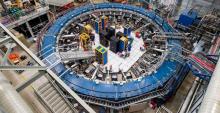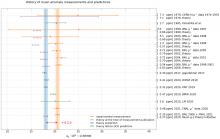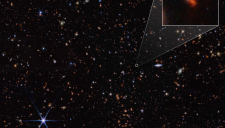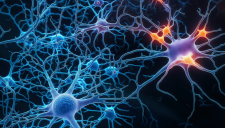A new measurement of the anomalous magnetic moment of the muon was revealed yesterday. The collaboration of physicists that performed the measurement includes Alberto Lusiani, employed at Scuola Normale Superiore and associated to the Italian INFN.
Pisa, April 8, 2021
After three years of analysis of data collected in 2018 at the Fermilab laboratories near Chicago, the international collaboration E989, which involves about 200 scientists from all over the world, and includes a significant contribution from Italy sponsored by the “Istituto Nazionale di Fisica Nucleare” (INFN), will release a new measurement of the “anomalous magnetic moment of the muon”.
This is a long-awaited result in Particle Physics. Physicists want to find out whether an existing inconsistency of a previous measurement, carried out at Brookhaven in the years 1997 to 2006, is evidence that there exist new particles or fundamental forces of Nature that are not yet known. On April 7, during a seminar at Fermilab, the physicist Chris Polly, co-leader of the Muon g-2 experiment, will present the findings.
«The new and more precise measurement of the muon magnetic moment deviates from the theory prediction by 3.3 standard deviations (or sigma), and, combined with the previous measurements, which were concluded in 2006, corresponds to a deviation of 4.2 sigma», explains Alberto Lusiani, researcher at Scuola Normale Superiore and INFN. «In the Particle Physics community – adds Lusiani – the observed deviation corresponds to evidence of New Physics, while 5 sigma are required to claim the discovery of a new phenomenon».
The result was unveiled on February 25, simultaneously, for all E989 collaborators, by Alberto Lusiani, who shared the screen of his personal computer in a virtual remote conference. Lusiani has been responsible for statistically combining a series of about 100 measurements from the experiment, and also to perform the final decryption of the numerical result in the dedicated conference of February 25. The E989 researchers analysed the data in a “blind” mode since 2018 and until the day of the unblinding meeting, to prevent being biased, even unconsciously, by the value of the result. All attendants had previously committed not to disclose the result before the date of the first public presentation at Fermilab on April 7.
The muons, belonging to the family of leptons together with electrons and tauons or tau leptons, are well described, like the other known elementary particles, by the “Standard Model”, a theory formulated in the 1970s that has been confirmed by a large number of experimental tests. The Standard Model predicts that the muon has a “magnetic moment”, like a rotating charged macroscopic sphere, but a little more than 2 times greater than a macroscopic sphere. The excess over 2 is called “anomalous magnetic moment” and is predicted by the Standard Model with an accuracy of better than one part per million.
In 2006, using data collected since 1997, an experimental collaboration measured the muon anomalous magnetic moment at Brookhaven with an accuracy of better than one part per million (one of the most precise measurements in Elementary Particle Physics), and found a difference of about 3 parts per million (3.7 standard deviations) from the Standard Model prediction. Thanks to Fermilab’s accelerators, scientists have been able to make new and more precise measurements, with the aim of shedding light on this inconsistency.
Alberto Lusiani was a former student at the Scuola Normale Superiore. Currently a researcher at the Normale and an associate at INFN in Pisa, he is an expert in verifying Particle Physics theory predictions with precision experimental measurements. He has participated and still participates to several international collaborations including ALEPH, BaBar, LHCb and E989, and coordinates since 2011, in the HFLAV (Heavy Flavour Averaging Group) collaboration, the calculation of the world averages of the measurements on the tau lepton and therefore the verification of the leptonic universality of the weak charged interaction and the unitarity of the first row of the Cabibbo-Kobayashi-Maskawa matrix with the measurements on the tau lepton. This second verification currently shows a not-yet-understood discrepancy with the Standard Model, which could lead to new discoveries. Since 2016, Lusiani belongs to the Particle Data Group, which annually collects all Particle Physics experimental measurements to obtain world averages that are compared with the respective theoretical predictions.
Useful links:
-
Repubblica.it (with Alberto Lusiani interviewed)
-
Askanews (reporting the INFN accouncement).
The attached images show:
1) Fermilab, Muon g-2 experiment.
2) History of the experimental measurements of the anomalous muon magnetic moment since 1979, compared with the theory predictions at the time of the measurements and with some additional recent theory predictions. The plot includes the measurement announced at Fermilab on April 7, 2021, the new experimental world average, and the 4.2 sigma discrepancy with the theory prediction.













